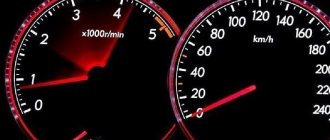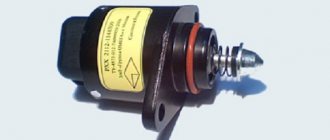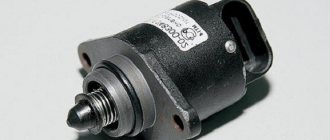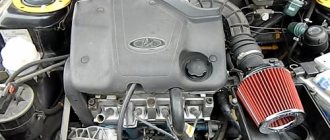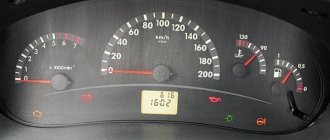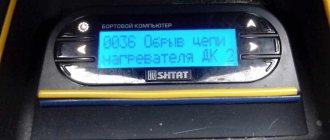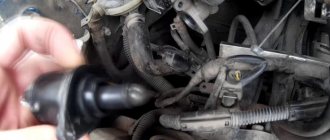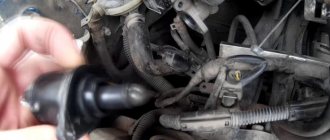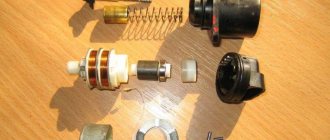Idle speed is a specific mode of engine operation, due to which the minimum amount of fuel burns in the cylinders. At the same time, the car does not stall, but continues to move. The minimum amount of combustion fuel required to operate the engine may vary depending on the temperature and design features of the engine. A problem that car owners sometimes encounter is high engine idle speed. Is this deviation dangerous? Without a doubt! When the minimum fuel rate increases, the car will not only stall at idle or consume too much fuel in this mode, but also release more toxic exhaust gases. Therefore, the causes of such a malfunction, as well as methods of elimination, should be known to every car owner.
What is high engine speed
High revolutions can be defined as the engine working too hard, which is a deviation under idle conditions. In this situation, irregular fuel distribution occurs and the unit overheats. It is important that at the moment of startup, high speeds are not considered a breakdown. But after that they must fall.
High rpm can be determined in three ways:
- look at the tachometer. If its readings at idle speed exceed 950 rpm, it’s time to be alarmed. Although lower indicators may also be a cause for concern: it all depends on the design features of the internal combustion engine; if other indicators are the norm, this will be indicated in the technical passport;
- by ear (if the speed increases, the internal combustion engine begins to operate more noisily);
- a car with an injector has a special indicator on the dashboard (“Check engine”), which will light up in case of deviation.
Tachometer shows engine speed
How to detect
Any driver can understand that the engine speed is higher than normal. To the ear, the sound and vibration of the engine at high speeds is much louder, and at idle the car becomes quiet. In addition, the car is equipped with a “tachometer”, by which you can understand the increased or decreased speed of your engine. Of course, each engine model has its own idle speed.
Therefore, I can only roughly suggest that the norm is considered to be from 650 to 550 idle speed on a warm engine; look for more details in the passport of your vehicle. When the RPM value exceeds normal values, this is considered a deviation for which the cause must be sought. In injection cars, a light on the dashboard lights up if the speed is increased, with the image of the engine “Check Engine”. Consequences
The first unpleasant consequence is, of course, an increase in fuel consumption. Because some of the fuel is simply released through the exhaust manifold. The service life of the motor is also not for the better. Because working with increased load wears out parts faster. The node itself, due to which this happens, can also become unusable.
That is why, when this problem appears, it must be eliminated immediately, and not wait until major troubles arise.
Causes of high speed on the carburetor
Since the “engines” on the injector and on the carburetor are structurally different, the reasons for high speeds at idle conditions also differ. Despite the fact that today cars with carburetors have been discontinued, there are quite a large number of them on the roads. Therefore, the problem of high idle speed cannot be eliminated. And the reasons for it may be the following:
- the ratio of fuel and air supplied to the carburetor is off, which is possible if it is repaired or configured incorrectly;
- failure of the throttle valve, which may be accompanied by two circumstances: accumulation of soot; formation of a crack, chipping (a very unpleasant situation that entails its replacement);
- failures in dosing of incoming fuel. This occurs if the needle valve is stuck;
- perhaps the choke is open, which is diagnosed by the operation of the primary chamber damper;
- A common cause is a burnt gasket on the cylinder head. You can verify such a breakdown by opening the radiator cap with the car running. White smoke coming out? That's right, the gasket is unusable.
Repairs are made easier by the absence of sophisticated electronics inherent in injection engines, since all the shortcomings are purely mechanical in nature.
Ignition system
Some car owners often overlook malfunctions in the functioning of the car's ignition system, which can cause an increase in speed. There are three reasons for this at this point:
- candles are acting up;
- high-voltage wires do not provide impulse passage;
- Damage to the ignition distribution cover.
If these problems are identified, then in most cases, replacing the listed system components helps eliminate them.
Conclusion
Many car enthusiasts do not know the reasons for the effect of floating engine speeds at idle or too high speeds, much less how to eliminate them. So, of course, experts and car mechanics recommend contacting a car service straight away, but our man won’t stop until he tries it himself.
There are many reasons for the effect of increased speed, from faulty sensors to errors in the electronic control unit. You can also fix the problem at home, which is what owners of VAZs and other domestic cars do. But owners of foreign cars will have to contact a car service center, where repairs can amount to a considerable amount.
Reasons for high speed on the injector
On the injector, the reasons why the speed increases can be divided into:
- related to electronic malfunctions;
- associated with mechanical problems.
In the first case, the sensors or controllers are acting up. In case of malfunctions of this kind, it is best to seek the help of specialists.
Throttle valve
If the reason lies in the poor functioning of the throttle valve (in most cases, it becomes jammed), the following happens:
- the volume of air entering the cylinders increases disproportionately;
- The ECU will "demand" more fuel to balance the mixture.
As a result, the car will not only consume much more fuel than it should, but it may even fail due to constant “overload” at high idle speeds. Diagnostics of the damper and, depending on the diagnostic results, chemical cleaning or replacement will help resolve the problem.
Engine temperature sensor
This device is considered subject to frequent failures, since it is located in the epicenter of inevitable temperature changes. If it was noticed that with certain initial conditions everything is in order with the motor, but the sensor is “playing naughty”. To diagnose, you will have to delve into the wiring.
With the ignition on you need to:
- take data on the resistance from contact “A” to ground (the exact correct value is 10 Ohm);
- take data on the resistance from ground to terminal “B” (if less than 10 Ohms, you need to sound the alarm;
- also take data on the voltage at terminal “B” in relation to ground (the exact correct value is 5V).
There may be a problem with the sensor itself. To determine this, you need to take the above resistance readings with the engine cooled down and warmed up. When working properly, the readings should not differ.
Engine temperature sensor
Air flow sensor
The oil film that envelops this device during vehicle operation eventually leads to malfunctions of the element that measures and sends a signal to the computer about the amount of incoming air (hot-wire anemometer). As a result, the ECU does not have access to reliable information about the amount of air, and the speed begins to float. But first of all, it is worth inspecting the air filter. Perhaps it is simply clogged and air is not flowing freely.
Intake manifold
High speeds may be associated with air suction. There can be two types of faults in this unit:
- deformation of the intake manifold;
- breakdowns or burnout of the gasket.
If the second case is not so catastrophic, then the first will most likely lead to a call to the services of a car service, since grinding may be required. Problems will be detected, including when the engine warms up.
Other reasons
Other common reasons may be the following:
- jamming of the gas pedal, which is typical for both an injector engine and a carburetor engine;
- On the injector, the IAC (idle air control) and TPS (throttle position) sensors may fail: if there is a suspicion that it is they who are “sinning,” you will need to check the contacts;
- ECU failures, which are checked using special computer programs;
- the generator does not supply the required current rate, so the motor will begin to accelerate in pursuit of the required voltage;
- For cars with a turbocharger, high speeds at idle can be caused by its wear or depressurization of the rotor shaft gasket.
If you cannot confidently identify the cause of the increase in speed, it is more prudent to contact specialists (especially in the case of an injector).
Intake manifold with throttle valve
What's the result?
It should be noted that the idle problem on an engine with an injector is diagnosed by checking the main systems that are responsible for the flow of air into the internal combustion engine, as well as changing the mixture composition taking into account the amount of incoming air. It turns out that you should also take into account the fact that the failure of individual ECM sensors can lead to an increase or floating idle speed.
In the general list of the main reasons why idle speed can increase on the injector, there are: idle speed regulator, TPS, power unit temperature sensor, problems with the throttle valve opening control mechanism, intake air leaks. Let us add that before in-depth diagnostics, you should first carry out the procedure for cleaning the throttle valve, since a dirty throttle is a common cause of increased speed or unstable operation of the engine at idle.
Remedies
Having accurately determined the cause of the problem, you can begin to eliminate it, which in many cases is done by yourself:
- If there is an excess of fuel supplied, you need to inspect the throttle valve. Depending on its condition, clean it or replace it with a new one;
- if there is an excess of air, you need to examine the intake manifold for leaks and gaskets for leaks: bad gaskets will have to be replaced, and with deformations or damage to the manifold, it is better to contact a specialist;
- with electronics it’s a little more complicated: the ECU will require “reflashing”, which is highly undesirable to do on your own; failed IAC and TPS will require replacement, which also applies to temperature and air flow sensors; When accurately diagnosing a problem with electronic contacts, soldering is necessary;
- problems associated with a sharp increase in speed, as a rule, are rooted in jamming of the mechanisms that provide fuel supply. Since they are susceptible to blockages (this includes the operation of the needle valve; if there is a problem with the supply, it needs to be replaced or cleaned);
- Short circuits or voltage surges are the first enemies of electronics. Therefore, a possible solution to the problem may be to repair the generator or ignition system;
- If the reason lies in the jamming of the gas pedal, first of all check whether a foreign object has rolled under the pedal.
When installing new sensors (IAC), we must not forget to enter data into the “memory” of the ECU. Otherwise, the electronic brain simply won’t see them.
Idle speed: what is it?
In all devices of a mechanical or electrical operating principle, there is such a thing as idle speed.
In simple words, idling is the absence of load, in this case on an internal combustion engine. The correct operation of the internal combustion engine is shown, in many cases, by the behavior of the engine at idle, that is, vibration in idle mode and the noise of the engine (there are no noise jumps from louder to quieter). If these indicators are stable, this is considered normal engine operation at idle speed (idling speed).
Methods for solving the problem
Before proceeding directly to the process of solving the problem, you need to understand that diagnostics and repair of these components should be performed only with knowledge of the matter. Also, it is worth separately noting that for a carburetor and injection engine there will be different diagnostic methods, but the principle of the causes is the same.
So, it is worthwhile to consistently understand the diagnostic and repair work that will eliminate high idle speed.
IAC sensor
It is not often possible to find an idle air control sensor on carburetor engines. This is usually done using a quality and quantity screw. To normalize high idle speeds, you should not carry out the process cold. First, you should warm up the engine to operating temperature, and only then begin adjustments. If after making the adjustments the speed remains high, then the reason is different.
For an injection engine, the opposite is true; all adjustments are made by the IAC sensor. In order to correct the malfunction, it is worth checking the sensor with a multimeter, and then, if the element is faulty, replace it with a new one.
TPDZ
The wrong amount of air entering the combustion chamber can cause the ECU to over-idle. If the throttle position sensor is faulty, it must also be checked. This can be done with a multimeter or oscilloscope. If it is discovered that the TPS is faulty, it is worth replacing it.
We recommend: What function does the timing chain perform?
Motor temperature sensor
A failure of the temperature sensor can lead to many problems. One of these will be an increase in idle speed. Typically, as practice shows, this sensor is the most vulnerable and most often fails because it is exposed to temperature changes.
First, it’s worth diagnosing the health of the unit. This can be done using a multimeter and an oscilloscope. If the unit is faulty, it should be replaced. After this, it is recommended to reset all ECU errors.
Collector
Often, due to the use of the vehicle, the intake manifold becomes deformed or the gasket wears out. Thus, an increase in idle speed may indicate that there is an air leak in the manifold. To treat the malfunction, you will have to dismantle the part, which is quite problematic, since almost the entire injection system and several components of other systems are attached to the manifold.
It is worth examining the manifold gasket in detail; the presence of damage may indicate not only problems with speed, but also other malfunctions. Also, deformation of the cavity can cause excess air to enter the combustion chambers. This can affect warming up, engine starting and other factors.
To fix the problem, you will have to grind the surface of the collector until it is smooth. In car services, this is done using a special machine. Of course, you can carry out the process in a garage, using a special stone, but this is not always possible for car owners.
Electronic control unit
Repeatedly high idle speed is a consequence of incorrect operation of the electronic control unit. So, to troubleshoot a problem, you will have to connect to the “brains” and fix the problem at the software level. To complete the process you will need a special cable and software.
But simply resetting errors does not always help; you often have to change the software in order for all the problems to finally go away. It is recommended to trust this process to masters who are professionals in their field.
Along with replacing the firmware, you can increase the power characteristics, which is also recommended to be entrusted to specialists. As practice shows, most car enthusiasts, when independently tampering with the ECU, end up in a car service center to eliminate the consequences of their own modifications.
Unstable idle: what to look for first
When the idle starts to act up, the first thing we think about is the sensors. This was the case with the appearance of vibration at idle speed of the Lada Vesta, this also occurs on many other foreign cars. They say, again this electronics, but this was not the case on the carburetor. But no.
A loose clamp can cause the engine to wobble. Free air intake means that there will be more oxygen in the cylinders, and there will be more fuel, which is why the result will not be long in coming - the speed will immediately increase. Standard suction points are:
- Leaks, cracks in the intake manifold.
- Damaged, aged fuel injector seals.
- Poor quality sealing of key sensors located along the intake tract.
Sensors and regulators, of course, cannot be ruled out. On the black list:
- Throttle position sensor.
- Idle speed regulator.
- Mass air flow sensor or absolute air pressure and temperature sensor (depending on the air flow calculation model embedded in the ECU of a particular engine, i.e. either one or the other).
Reasons for an injector
Now let’s look at the reasons why injection engines have constantly high idle speeds. Unlike carburetor counterparts, where all the problems are with mechanical elements, the injector is stuffed with electronics, so this problem is a failure in the electronics.
The reasons may be:
- Malfunction or breakdown of the sensor that monitors the temperature of the coolant in the engine. If this sensor malfunctions, the speed is not reset, since the electronics believes that the engine has not yet warmed up and drives it in warm-up mode, which is why the increased speed remains. The problem can quickly overheat the engine and cause jamming of parts and severe damage, after which only expensive and time-consuming repairs. A diagnostic scanner can help identify this type of problem.
- A breakdown of the air sensor causes increased speed, as the correct air supply to the engine is disrupted. A diagnostic scanner can also help identify this malfunction. As well as problems with other sensors.
- After this, check the sensor using a multimeter to exclude a broken wiring as the cause.
- A malfunction of the sensor responsible for idle speed, if any, also causes malfunctions at idle speed. If after replacing the idle speed sensor the high speeds do not disappear, then it was not the cause.
- The throttle opening sensor also plays a key role when the speed increases. If it is not working correctly, the computer believes that the damper is fully open and increases the speed, supplying more fuel to the cylinders.
- The sensor may have nothing to do with it, the damper itself is jammed due to dirt, or the spring on the damper, which is supposed to close it, has stretched, in addition, this spring sometimes jumps off or breaks, so the engine keeps high speeds. In this case, it needs to be corrected, if possible, or replaced.
- The damper control cable is stuck. This malfunction was common in older car models. Then it’s worth lubricating or replacing this cable.
- The sealing gaskets on the injectors are damaged. This is a difficult malfunction to check, and quite rare, so it should be checked as a last resort, when other faults have been excluded. Broken gaskets allow air to enter the combustion chambers, which also increases speed.
Useful video about this problem
The injector also has many reasons for such a malfunction, and if it occurs, it is also worth taking care of solving it as soon as possible, before the problems become more serious.
This situation also happens when you change the idle speed sensor and the speed becomes high. There are several reasons here, the sensor itself is faulty, this is not uncommon now, when a new spare part may turn out to be unusable, there is a problem with another sensor, then we continue to look.
This happened to a friend of mine due to a break in the wiring on the sensor connector, which he discovered after changing all possible sensors, and was about to reflash the computer’s brains. Therefore, in addition to the sensors, do not forget to check the fuses and the condition of the wiring. If there is no visual damage, you can check with a multimeter.
We recommend: Fuel system VAZ 2107 injector: characteristics, malfunctions, reviews, how to clean and adjust, instructions with photos and videos
This is what could be the reason for high engine speeds, the main thing is to quickly calculate and eliminate it, I have everything for today, subscribe your friends to updates, and subscribe yourself, there will be a lot of useful things, don’t forget to send a link to the site for those who don’t know about it yet, see you.
Electronics failures
Idle speed control
Checking the engine idle speed control
After replacing the idle air regulator, it must be “registered” i.e. enter its parameters into the ECU memory.
The idle air control (IAC) is a stepper motor (solenoid) that operates from pulse signals supplied by the electronic control unit (ECU) . It works in a similar way to the screw for adjusting the amount of mixture in the carburetor - when the valve extends, it closes the fuel channel, and when it moves back, it opens it. It often happens that the regulator core simply jams and it stops responding to ECU signals. Moreover, you can damage the idle air regulator even in the store when purchasing it - by trying to turn or press the valve needle with your hands. If after replacing the idle speed sensor (regulator) there are high speeds, then most likely the problem is either in the ECU or in the mass air flow sensor - all the elements that make up the power system work in interaction, and diagnostics need to be carried out. It is quite possible that you will have to “register” a new regulator - that is, enter its parameters into the ECU memory.
temperature sensor
This sensor can also affect the engine fuel system. By issuing an incorrect signal (corresponding to a low temperature) to the ECU, it will cause the controller to give a signal to other elements of the fuel system (including injectors) that the mixture is enriched. An incorrect sensor signal will result in idle speeds exceeding 1000 min-1.
Mass air flow sensor
The mass air flow sensor directly affects the quality and quantity of the mixture supplied to the cylinders - after all, the ECU “knows” about its composition thanks to this (and some other) sensors. In conclusion, if your car’s engine has increased idle speed for no reason, first look for the cause in possible jamming of the fuel system mechanisms - after all, they are the ones who are primarily exposed to various contaminants, and for electronic components, power surges or short circuits are much more dangerous.
We recommend: Signs of a faulty automatic transmission control unit. Helpful information
Excess fuel supply
Cleaning the throttle body
A completely different situation will arise if not just excess air, but an air-fuel mixture enters - for example, through a gap formed as a result of loose closing of the throttle valve. In this case, the high idle speed of the engine will be stable. The fuel systems of some engines provide semi-automatic control of the fuel supply during engine warm-up mode - due to this, high idle speeds are maintained until the engine warms up to the set temperature. Fuel is supplied through a channel that bypasses the throttle valve. Such a channel can be closed/opened in various ways - the valve in it has either an electric drive (solenoid), or it can be arranged like a refrigerator thermostat - when the engine warms up, the channel is locked.
At high idle speeds, you should check the entire throttle valve assembly with sensors and idle control.
In any case, such a valve may break, and then excess fuel will always flow into the intake manifold, which will cause high idle speeds after the engine has warmed up. In all such cases, first of all, you need to remove the throttle body and wash it with a special solution - there are a lot of similar “chemicals” sold in stores. After washing, you need to carefully inspect the assembly - especially for sticking or, on the contrary, excessive looseness of the throttle valve. The throttle valves of some injection engines also have a screw for adjusting the idle speed of the engine or limiting the closing of the valve - you should also pay attention to them - whether the unit can be adjusted. Often, the engine speed does not drop at idle due to the gas cable getting stuck or foreign objects getting under the pedal - the corner of the mat, for example. Of course, almost all of the above can also apply to carburetor engines. In addition, a typical malfunction (or, more precisely, a deviation from the norm) for them is incomplete opening of the air damper - mainly due to incorrect installation of the choke cable. In the absence of breakdowns, the normal idle speed of a carburetor engine is set by adjustment using two screws - the “quantity” and “quality” of the mixture.
